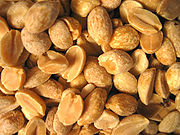Natural history of peanut allergy: strong association between high peanut-specific IgE and reaction severity
 Peanut allergy affects 1% of children.
Peanut allergy affects 1% of children. This study from Johns Hopkins University included 780 patients, mostly children, with peanut allergy. The median age at initial observation was 1.4 years. There was a classic expression of the allergic (atopic) march in that cohort:
- 93% were avoiding other foods
- 71% had atopic dermatitis
- 57% had allergic rhinitis
- 56% had asthma
Allergic (atopic) march (click here to enlarge the image):
The median initial peanut-specific immunoglobulin E (P-IgE) was 28 kU/L, and the median peak P-IgE was 68.
The exposures to peanuts consisted mostly of ingestion (76%), and much less frequently to contact (14%), and 4.5% airborne.
Symptoms after exposure consisted of:
- 74% urticaria/angioedema
- 22% lower respiratory symptoms
- 21% gastrointestinal symptoms
- 8% oral erythema/pruritus
Treatment of allergic reactions included mostly antihistamines (33%). Emergency department visits was required in 16%, and epinephrine was administered only in 13%. Albuterol was needed only in 3% of reactions.
Reaction severity did not change with repeated exposure. Severe reactions were associated with higher P-IgE, but not with age, sex, or asthma.
There was a strong association between higher peanut-specific immunoglobulin E (P-IgE) levels and reaction severity.
References:
The natural history of persistent peanut allergy. Neuman-Sunshine DL, Eckman JA, Keet CA, Matsui EC, Peng RD, Lenehan PJ, Wood RA. Ann Allergy Asthma Immunol. 2012 May;108(5):326-331.e3. Epub 2011 Dec 23.
Image source: Roasted peanuts as snack food, Wikipedia, public domain.